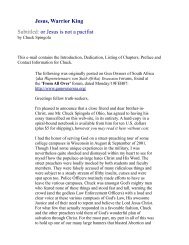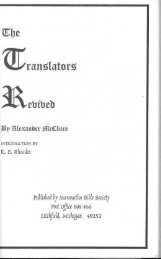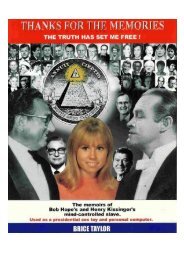THE PINK SWASTIKA - Shattering Denial
THE PINK SWASTIKA - Shattering Denial
THE PINK SWASTIKA - Shattering Denial
You also want an ePaper? Increase the reach of your titles
YUMPU automatically turns print PDFs into web optimized ePapers that Google loves.
“Fems” and the “Butches.” These terms are common among homosexuals today, as is the disdain<br />
“Butches” feel for “Fems.”<br />
A researcher of the homosexual movement Gordon Westwood writes that masculine homosexuals<br />
“deplore [effeminate] behavior,” many considering effeminate homosexuals “repulsive” (Westwood:<br />
87). Another researcher, H. Kimball Jones, reports that reaction to “Fems” is often violent in the<br />
general homosexual community. “[They label them] ‘flaming faggot’ or ‘degenerate fag,’” with one<br />
homosexual exclaiming, “You know, I loathe these screaming fairies” (H.K.Jones:29). Jay and Young’s<br />
1979 examination of the American homosexual movement, The Gay Report, contains numerous<br />
personal statements by masculine homosexuals critical of effeminacy. “Fem behavior can be vicious<br />
and destructive, demeaning to women and gay men,” says one. Another asserts, “To me someone who<br />
is ‘femme’ is a self-indulgent...petty, scheming, gossipy gay being whose self-image has been warped<br />
and shaped by unfortunate family situations” (Jay:294ff).<br />
The most hostile to “Femmes” are precisely those homosexuals who deem themselves the most<br />
“masculine.” In The Homosexual Matrix, C.A. Tripp writes that “[f]ar to the other extreme, there are a<br />
number of utterly masculine, sometimes supermasculine homosexuals....They are obses- sed with<br />
everything male and eschew anything weak or effeminate....Unquestionably they represent the epitome<br />
of what can happen when an eroticized maleness gains the full backing of a value system that supports<br />
it” (Tripp:92). Cory and LeRoy, in their detailed discussion of homosexual culture, describe the scene<br />
in a typical American “leather bar”:<br />
Here, sturdy swaggering males dressed in tight dungarees, leather jackets or heavy shoes, dark hued<br />
woolen shirts, and sometimes motorcycle helmets, aspire toward a super-masculine ideal...Behind the<br />
facade of robust exploits, the uniform of pretentious male prowess, the mask of toughness, there<br />
sometimes lies a dangerous personality that can express itself physically by substituting violence for<br />
erotic pleasure; capable of receiving sexual pleasure only by inflicting pain (or receiving it). The<br />
general atmosphere in such places is restless and brooding, and one can never be sure when the<br />
dynamite of violence will erupt (Cory and LeRoy:109).<br />
Reading this description, one can imagine oneself looking into Munich’s Bratwurstgloeckl tavern,<br />
where the Brownshirts congregated, and finding the same cast of characters -- only wearing different<br />
costumes.<br />
This contrast of homosexual types is not simply a phenomenon of modern society. Greenberg writes<br />
about homosexuality among the Germans of the first centuries A.D.:<br />
As war became more important to the Germans, the male warriors and their culture became dominant,<br />
and the status of women declined. Effeminacy and receptive homosexuality were increasingly scorned<br />
and repressed....The effeminate homosexual...was depicted as a foul monster....this stigmatization did<br />
not extend to active male homosexuality. [Later, acceptability of masculine oriented homosexuality<br />
declined under Christianity, which] was officially opposed to all forms of homosexuality (Greenberg:<br />
249f).<br />
The authors do not wish to imply that all homosexuals fall into one or the other of these two<br />
simplistic stereotypes. The terms “Butch” and “Fem” in this study are used loosely to differentiate<br />
between two ideological extremes relating to the nature of homosexual identity. Generally in this work<br />
the German “Fems” are defined as homosexual men who acted like women. They were pacifists and<br />
accomodationists. Their goals were equality with heterosexuals and the “right to privacy,” and<br />
generally they opposed sex with young children. Their leaders were Karl Heinrich Ulrichs and Magnus<br />
Hirschfeld.









